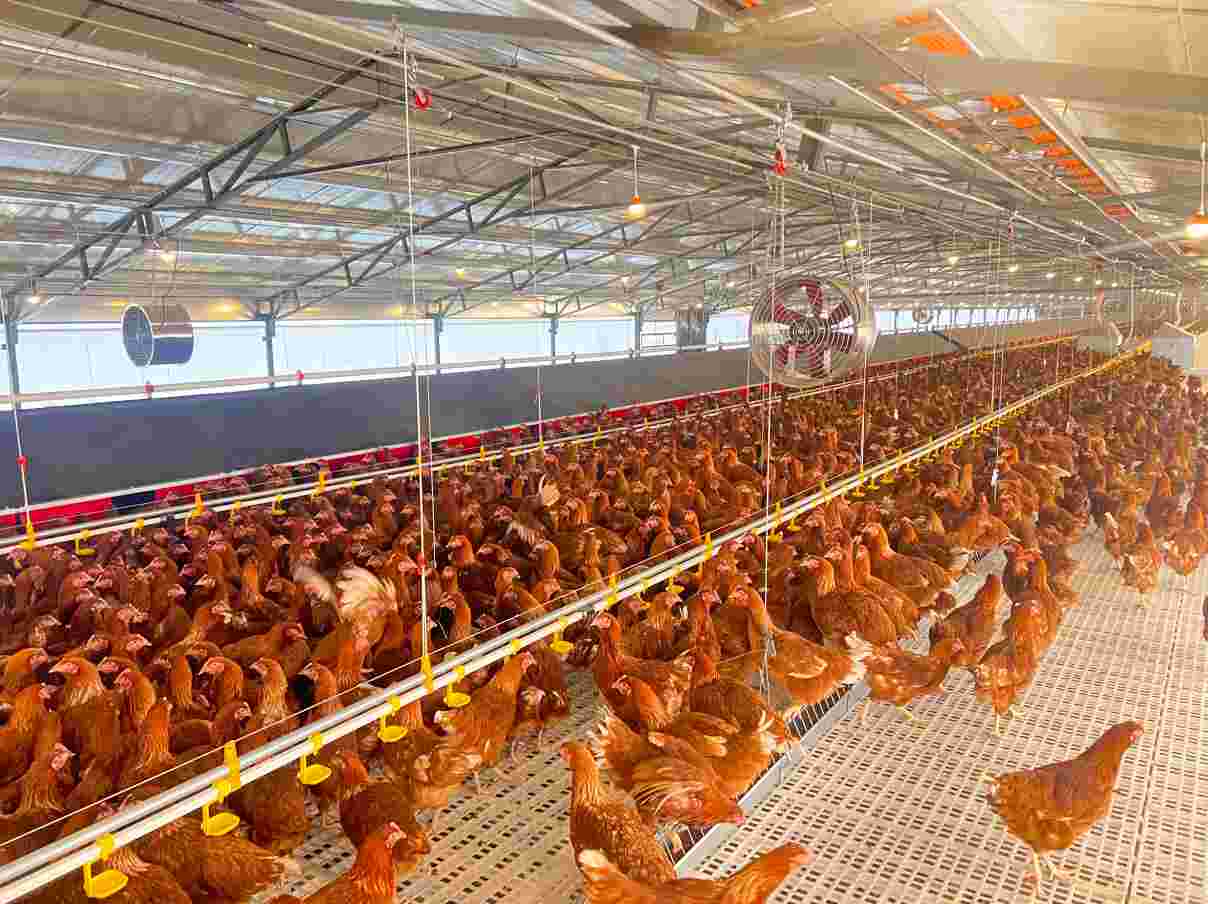Exploring Poultry Farm Feeders Basics
What’s a Poultry Feeder?
A poultry feeder is a key part of chicken gear, built to hand out feed to birds in a neat and quick way. Its main job is to give steady eats while cutting work and feed spill. An efficient feeder reduces spillage, keeps feed dry and fresh, and ensures the smallest chickens can eat just as well as the biggest. These feeders come in different looks, from simple troughs to fancy auto poultry feeder setups that fit broilers, layers, and chicks.
Today’s feeders cut waste and keep clean by stopping mess from poop or bedding. Bad feeders can cause big spill, dirt, or uneven grab for birds, hitting growth and health. Picking the right feeder matters big for even flock run and feed save.
Why Poultry Feeders Matter in Today’s Farming?
In big farm spots, poultry feeders are must-haves by auto hand-out feed. This auto cuts hand work big and keeps even feed all over the chicken house. We’ve seen how a top feeder can shift farm day, save time and feed cash while upping birds’ eat fun.
Plus, feeders let farmers watch eat habits that may show health probs or slow spots. Right feeder use backs best growth in broilers and max eggs in layers. These ups fit green farm ways by drop stuff use per make.

Kinds of Poultry Feeders and What They Do
Which Feeder Fits Chickens Best?
The top poultry feeder hangs on flock size, age, house setup, and feed style. For small or backyard groups, gravity feeders are cheap and easy fix. They work on simple pull where feed drops as birds eat.
For big ops, auto poultry feeders win from high work and set hand-out. Many flock bosses wonder how to mix cost, tough, and clean easy. Auto feeders fix these while feed big groups even without steady watch.
Key Bits to Think When Picking Poultry Feeder
Hold and Stuff Tough
Feeders with big hold cut refill times, save time and drop bird stress from lots human move. It’s key to pick stuff that takes outside hits and wear.
Choosing durable, eco-friendly materials help align poultry keeping with environmental responsibility. Materials like UV-resistant plastics or hot-dip galvanized steel—such as those used in ZEUS poultry equipment—provide long-term durability even in intensive environments.
Feed Flow Control Ways
Good poultry farm feeders have tweak flow systems that stop overfeed or jam. Anti-waste grills are another important feature that helps reduce spillage by limiting how much feed birds can scatter.
DIY systems often provide adjustable feeding ports to reduce waste and accommodate different bird sizes. Incorporating such mechanisms ensures controlled access and efficient conversion of feed into body mass or egg output.
Clean Easy and Upkeep
Feed clean matters in chicken work. Feeders with take-off parts let deep clean that stop mold and germ mess. The design of the feed tray makes it easy to clean, helping to maintain feed hygiene. This becomes especially important when using an automatic water feeder for chickens or other integrated systems that require sanitary conditions.
How Poultry Feeder Works Hit Feed Save
How Feeder Looks Change Feed Turn Rates?
Feeder look straight hits how good birds turn feed to meat or eggs. A solid feeder gives even grab for all birds, cut boss fights and rush at eat times. It backs natural eat moves and comfy.
Good looks also cut spill and mess. Our Poultry Feeding Barrels are designed to work in harmony with the feeding system, ensuring efficient distribution of feed. Combined with proper layout and density management, such mechanics support optimal feed conversion ratios (FCR).
What Part Does Feeder Height Play in Work?
Feeder height must fit bird size to push comfy eat poses. Wrong height can block small birds or up waste when feed scratched from low trays. The Suspension System of our broiler feeding equipment is designed for ease of use and flexibility allows for easy height adjustments.
Tweak hang systems keep feeders grabby as birds grow, big in broiler work where growth fast.

Mix Poultry Feeders Into Farm Run Systems
How Auto Feeders Back Big Poultry Ops?
Auto has changed today chicken run. Auto poultry feeders hand feed at set times, cut hand in while up even eat.
Our ZEUS feeding systems integrate programmable motors, auger transport mechanisms, and sensor-driven feedback loops for precise control. The Broiler Feeding System offered by our company is a testament to our commitment to innovation ensures a consistent supply of feed, reducing the risk of feed wastage.
This control level big useful in spots over 25,000 birds where hand work would be tough and slow.
Can Smart Feed Systems Fit Diff Bird Growth Steps?
Yep, our systems have tweak pan heights, sensor auger, and mix setups that change with flock grow needs. The lifting system is flexible and diverse easily adjusting the height of the feeding line and water line to meet the needs of different growth stages.
By sure best eats in every grow step, change systems up health while cut waste.
Intro to Poultry Feed Systems from ZEUS
What Makes ZEUS Poultry Farm Feeders Pop?
At ZEUS, we push to build top feed fixes that hit hard needs of today chicken farm. Our stuff built for broilers and layers, made from top raw like hot-dip galvanized steel with 275g/m² coat. Our Poultry Feeding Equipment is crafted from high-quality raw materials ensuring a service life of 8-10 years.
We build every bit exact—from feed trays to hang systems—to up work in your op while push bird good.
Look at ZEUS Stuff Range in Poultry Feed Systems
Chain Feed Systems by ZEUS
Our chain feed systems give even feed hand-out across long cage rows—perfect for layer farms with stack cages. These systems cut work cash while keep high right.
Pan Feed Systems by ZEUS
ZEUS pan feeders built special for broiler houses. The height-tweak pans fit birds at diff grow steps. With anti-waste look in each pan, our system sure little spill and best feed use.
Auger Feed Systems by ZEUS
Our auger feed lines let smooth move feed from silos straight to pans or cages. Fit with German IFM sensors and special motors, these systems back high pack ops with little hand. The Feeder Sensor provides precise control over the feeding process, while the drive system ensures reliable operation.

FAQ
Q: How many kilos will feed 100 chickens per day?
A: On average, 100 adult laying hens consume approximately 10–12 kilograms of feed daily, depending on breed, age, and environmental conditions.
Q: Should I use hanging or floor-based feeders for my chickens?
A: Hanging feeders help reduce contamination from droppings and bedding but require height adjustment as birds grow; floor-based options are easier to refill but may lead to more waste if not properly managed.
Q: How often should poultry feeders be cleaned?
A: Feeder cleaning should be performed at least once per week in small flocks and more frequently in commercial operations to prevent mold growth and disease transmission.
Q: What’s the difference between a poultry farm feeder and a poultry waterer?
A: A poultry farm feeder dispenses dry feed while a poultry waterer supplies clean drinking water—both are essential components of complete poultry equipment setups.
Q: Can I use an automatic water feeder for chickens along with an automatic poultry feeder?
A: Yes. Combining both systems improves overall flock health by ensuring consistent hydration and nutrition while reducing labor requirements across your farm operations.

